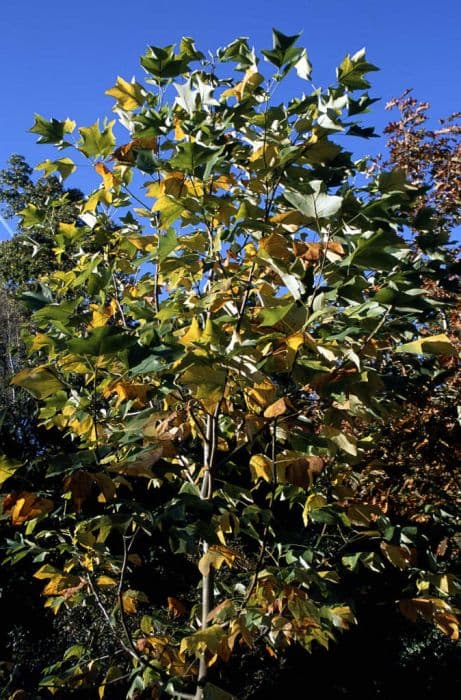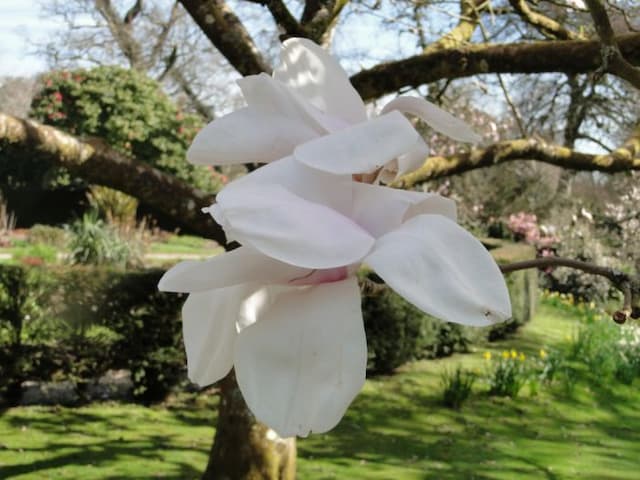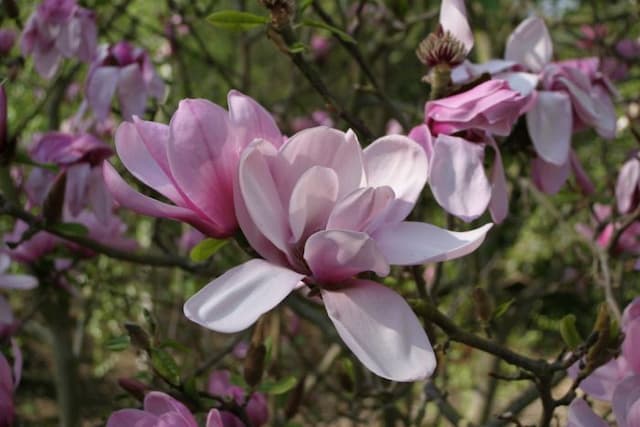Kobushi magnolia Magnolia kobus

ABOUT
Magnolia kobus, commonly known as the Kobus magnolia, is a visually striking plant admired for its elegant beauty. It is characterized by an impressive display of flowers, which are amongst the first to herald the arrival of spring. The blossoms are large and showy, with a creamy-white hue tinged with subtle hints of pink, exuding a light, fragrant scent. These flowers have a classic cup-and-saucer shape, creating a captivating spectacle against the backdrop of the plant’s expansive foliage. The leaves of the Kobus magnolia are a deep and glossy green, offering a lush, contrasting canvas for the brilliant flowers. They are oval-shaped with a pointed tip and have a leathery texture, usually arranged alternately along the branches. As the seasons transition toward fall, the foliage may turn to shades of bronze or yellow, adding a new layer to the plant’s aesthetic appeal. The silhouette of the Kobus magnolia is graceful and symmetrical, with branches spreading out to form a rounded appearance. The bark is smooth and gray, providing strength and structure to the plant. This magnolia's beauty is not fleeting; in the absence of blooms, the silver-gray bark and the plant’s overall shape contribute to its year-round visual interest. As the plant matures, it may bear fruit that resembles a cone, consisting of individual red seeds encased within a fleshy covering. These fruiting bodies, while not as conspicuous as the flowers, offer an additional feature of interest and can attract wildlife such as birds, which are drawn to the seeds. With its stunning flowers, glossy foliage, and attractive form, the Kobus magnolia is a cherished selection in many gardens and landscapes, creating a focal point that captures the attention of passersby and provides soothing natural beauty across the changing seasons.
About this plant
 Names
NamesFamily
Magnoliaceae.
Synonyms
Kobushi Magnolia, Kobus Magnolia, Northern Japanese Magnolia.
Common names
Magnolia borealis, Magnolia tomentosa, Magnolia kobus var. borealis, Magnolia kobus var. tomentosa, Yulania borealis, Yulania kobus, Yulania kobus var. borealis, Yulania tomentosa
 Toxicity
ToxicityTo humans
Magnolia kobus, commonly known as Kobushi magnolia, is not widely recognized as a poisonous plant to humans. There is no significant evidence to suggest that ingestion of parts of this plant by humans leads to poisoning. Its flowers and buds have been used in traditional East Asian cuisines, implying they are generally considered safe to eat in small quantities. However, like any plant material, individual allergies or sensitivities can exist, and consuming plant parts in large amounts could possibly cause stomach upset or allergic reactions in some people.
To pets
Kobushi magnolia is not considered to be highly toxic to pets. There is limited information available on the specific effects of this plant on animals, but it is generally not associated with severe toxicity. Nonetheless, it's still possible for pets, like cats and dogs, to experience mild gastrointestinal upset if they consume a significant amount of plant material. Signs of such a response might include vomiting or diarrhea. To keep pets safe, it's best to prevent them from chewing on or ingesting garden plants, as individual animals might have different sensitivities or allergies.
 Characteristics
CharacteristicsLife cycle
Perennials
Foliage type
Deciduous
Color of leaves
Green
Flower color
White
Height
25 feet (7.62 meters)
Spread
30 feet (9.14 meters)
Plant type
Tree
Hardiness zones
5
Native area
Japan Korea
Benefits
 General Benefits
General Benefits- Landscape Aesthetic: Magnolia kobus, commonly known as the Kobus magnolia, is valued for its beautiful white or pale pink blossoms that provide an impressive display in early spring.
- Shade Provider: With its dense foliage, the Kobus magnolia can offer a cool, shaded area in gardens and parks during hot summer months.
- Wildlife Habitat: The tree provides habitat and food for various wildlife, such as birds and pollinators, which are attracted to its flowers and later to its fruit.
- Seasonal Interest: The Kobus magnolia has year-round interest, from its fragrant flowers in spring, to its green leaves in summer, and to its decorative fruit and autumn leaf color.
- Low Maintenance: Once established, the Kobus magnolia requires minimal care, making it a good choice for gardeners looking for low-maintenance landscaping options.
- Tolerance to Conditions: This magnolia species is known for its ability to withstand cold temperatures better than many other magnolias, opening up its use to a wider range of climates.
 Medical Properties
Medical Properties- Anti-inflammatory: Magnolia kobus bark extracts contain compounds that may help reduce inflammation.
- Antioxidant: The plant is known to possess antioxidant properties, which help in neutralizing free radicals in the body.
- Anxiolytic: Some studies suggest that honokiol and magnolol, compounds found in Magnolia kobus, could have an anxiolytic effect, helping to reduce anxiety.
- Neuroprotective: Components like magnolol can provide neuroprotective effects, possibly beneficial for neurodegenerative disorders.
- Antibacterial: Extracts from Magnolia kobus have been studied for their antibacterial properties, especially against certain strains of oral bacteria.
- Anti-tumor: There is preliminary evidence that the magnolol and honokiol in Magnolia kobus have anti-tumor effects.
 Air-purifying Qualities
Air-purifying QualitiesThis plant is not specifically known for air purifying qualities.
 Other Uses
Other Uses- Magnolia kobus wood is sometimes used in fine woodworking or cabinetry due to its hardness and grain structure.
- In Japan, the buds and young leaves of Magnolia kobus may be pickled and used as a spice.
- The flowers of the kobushi magnolia can be crystallized and used as edible decorations for desserts.
- Extracts from the leaves have been used historically in perfumery for their delicate fragrance.
- Fiber from the bark of Magnolia kobus has been utilized in paper-making processes in some East Asian cultures.
- The petals and buds of Magnolia kobus are sometimes used in floral arrangements, especially in Japan where it is a significant part of ikebana, the art of flower arranging.
- In some parts of the world, Magnolia kobus is planted as a street tree for urban beautification due to its striking appearance when in bloom.
- Magnolia kobus trees are often planted as a symbol of grace and beauty in botanical gardens and parks.
- The seeds of Magnolia kobus are sometimes used for educational purposes to demonstrate the anatomy of seeds and the process of germination.
- The plant can play a role in religious ceremonies; in some cultures, Magnolia kobus is considered a symbol of purity and is used in offerings and temple arrangements.
Interesting Facts
 Feng Shui
Feng ShuiMagnolia is often associated with purity and nobility, which makes it a favored choice in Feng Shui to promote a calming and dignified energy. It can be planted in the garden to attract positive chi, especially in areas where you wish to encourage new beginnings and growth, as magnolias are one of the first plants to bloom in spring.
 Zodiac Sign Compitability
Zodiac Sign CompitabilityMagnolia is not used in astrology practice.
 Plant Symbolism
Plant Symbolism- Nobility: The magnolia's long history of cultivation in Japanese and Chinese imperial gardens has imbued it with a symbolic meaning of nobility and dignity.
- Purity: The white color of many magnolia blossoms represents purity and cleanliness in symbolic terms, making it a popular plant in ceremonial occasions.
- Perseverance: As magnolias are early bloomers and can flower even in cold climates, they are seen to symbolize perseverance and endurance through tough conditions.
- Feminine beauty: The elegant and graceful form of the magnolia flower often signifies feminine beauty and gentleness in various cultures.
- Longevity: Magnolias can live for many years, and so they have become associated with longevity and the long span of life.
 Water
WaterThe Magnolia kobus, commonly known as Kobus magnolia, prefers consistently moist soil and should be watered once or twice a week during its growing season. The amount of water required can vary depending on climate conditions and soil type, but a good practice is to provide about 2 to 3 gallons for young trees each time you water, making sure to moisten the soil down to 8 to 12 inches. During hot, dry periods, you may need to water more frequently to maintain moist soil. In the winter, you can reduce the water supply since the tree will be dormant and its water requirements will decrease.
 Light
LightKobus magnolia thrives in full sun to partial shade. A location that receives at least four hours of direct, unfiltered sunlight per day is ideal. It can also do well in a spot that is sunny in the morning with some afternoon shade, helping to protect the tree from the intense heat of the day.
 Temperature
TemperatureThe Kobus magnolia is hardy and can withstand temperatures as low as -20 to -30 degrees Fahrenheit in the winter months, but it grows best in temperatures ranging from 60 to 72 degrees Fahrenheit. It is important not to plant the Kobus magnolia in areas where temperatures are consistently above 90 degrees Fahrenheit, as this can stress the plant.
 Pruning
PruningPrune Kobus magnolia to maintain its shape and remove any dead or damaged branches. The best time to prune is after the tree has flowered in late spring or early summer. Pruning should be done selectively, making clean cuts just above a bud or branch junction. Generally, Kobus magnolias require minimal pruning, and it's often sufficient to only remove problematic branches.
 Cleaning
CleaningAs needed
 Soil
SoilKobus magnolia thrives in acidic to neutral soil with a pH of 5.0 to 7.0. The ideal soil mix should be rich, organic, and well-draining. A combination of loamy soil, peat moss, and perlite in equal parts can create an optimal growing medium for this magnolia variety.
 Repotting
RepottingKobus magnolias do not require frequent repotting as they prefer to establish themselves in one location. Young trees may be repotted every 2-4 years to encourage growth, but mature trees should be repotted infrequently and only if necessary due to root constriction.
 Humidity & Misting
Humidity & MistingKobus magnolias are hardy plants that can tolerate a range of humidity levels, although they flourish best in moderate to high humidity. Ensuring good air circulation around the plant can help maintain healthy humidity levels for optimal growth.
 Suitable locations
Suitable locationsIndoor
Provide bright light, well-draining soil, and space for growth.
Outdoor
Plant in well-draining soil, full sun to partial shade.
Hardiness zone
4-8 USDA
 Life cycle
Life cycleThe life of Magnolia kobus, commonly known as Kobushi magnolia, begins with seed germination, which occurs when environmental conditions are suitable, typically in moist, well-draining soil. Following germination, the seedling emerges and grows into a young sapling, developing a root system and foliage. As the sapling matures into an adult tree, it establishes a sturdier trunk and extensive root system, while also producing distinctive, white fragrant blossoms in early spring before the foliage emerges. After pollination by insects, the flowers develop into aggregate fruit consisting of follicles that contain bright red seeds, which are dispersed by birds and mammals. Throughout its lifespan, the Kobushi magnolia experiences cycles of growth, flowering, and seed production annually. As a long-lived species, this tree may continue this cycle for many years, potentially living for several decades to over a century under ideal conditions.
 Propogation
PropogationPropogation time
Spring
The Japanese magnolia, or Magnolia kobus, is typically propagated via seed sowing. This popular method is often employed during autumn, directly after the seed collection. The seeds require several months of cold stratification to break their dormancy and encourage germination, which mimics the natural conditions they would experience over winter in their native habitat. This is achieved by mixing the seeds with slightly moist sand or peat moss and storing them in a refrigerator at about 33-41°F (1-5°C) for around 100 days. After stratification, the seeds can be sown in a well-draining seed starting mix and kept at room temperature with adequate light. Germination occurs in the spring, and once the seedlings have developed their first true leaves and are strong enough, they can be transplanted into individual pots or into the garden.









![Magnolia [Felix Jury]](/_next/image?url=https%3A%2F%2Fplants-admin.emdemapps.com%2Fimages%2Fplants%2F%2Fimages%2F604b61a0b23b7.png&w=640&q=75)